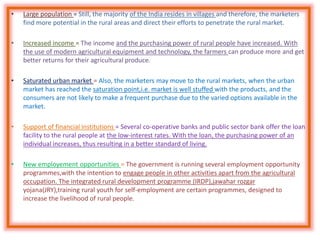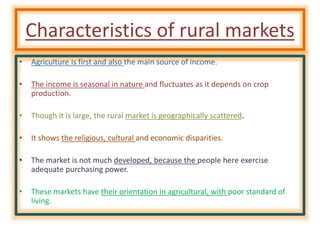Rural marketing
- 1. Rural Marketing Presented by = Rohit Arora
- 2. Meaning • “The rural marketing refers to the activities undertaken by the marketers to encourage the people, living in rural areas to convert their purchasing power into an effective demand for the goods and services and making these available in the rural areas, with the intention to improve their standard of living…”
- 3. Large,diverse and scattered market. (merely for rural peoples)
- 4. Two way process of rural Marketing i.e.., • Urban to rural = Fmcg goods, agricultural fertilizers, automobiles, etc. are offered by the urban market to the rural market. • Rural to urban = The agricultural supplies viz, fruits vegetables, flowers, milk, etc.is offered from the rural market to the urban market.
- 5. Potential of rural marketing Saturated urban market Increased income New employment opportunities Large population Financial institutions
- 6. • Large population = Still, the majority of the India resides in villages and therefore, the marketers find more potential in the rural areas and direct their efforts to penetrate the rural market. • Increased income = The income and the purchasing power of rural people have increased. With the use of modern agricultural equipment and technology, the farmers can produce more and get better returns for their agricultural produce. • Saturated urban market = Also, the marketers may move to the rural markets, when the urban market has reached the saturation point,i.e. market is well stuffed with the products, and the consumers are not likely to make a frequent purchase due to the varied options available in the market. • Support of financial institutions = Several co-operative banks and public sector bank offer the loan facility to the rural people at the low-interest rates. With the loan, the purchasing power of an individual increases, thus resulting in a better standard of living. • New employement opportunities = The government is running several employment opportunity programmes,with the intention to engage people in other activities apart from the agricultural occupation. The integrated rural development programme (IRDP),jawahar rozgar yojana(JRY),training rural youth for self-employment are certain programmes, designed to increase the livelihood of rural people.
- 7. Characteristics of rural markets • Agriculture is first and also the main source of income. • The income is seasonal in nature and fluctuates as it depends on crop production. • Though it is large, the rural market is geographically scattered. • It shows the religious, cultural and economic disparities. • The market is not much developed, because the people here exercise adequate purchasing power. • These markets have their orientation in agricultural, with poor standard of living.
- 8. Problem faced by rural marketing • Deprived people and deprived markets. • Lack of communication facilities. • Transport. • Low per capita income. • Low level of literacy. • Different way of thinking. • Warehousing problem. • Distribution problem.
- 9. Challenges in rural marketing • Standard of living = A large part of the population in rural areas lies below poverty line. Thus the rural market is also underdeveloped and the marketing strategies have to be different from the strategies used in urban marketing. • Low literacy levels = The low literacy levels in rural areas leads to problem in communication with the market. • Dummy brands = A lot of fake brands or products that look similar to the original one are available. • Lack of communication system = Quick communications facilities like computer, internet and telecommunication systems etc. are the need of rural market which is a biggest problem due to lack of availibility.
- 10. Conclusion • Rural marketing is a two-way marketing process. There is inflow of products into rural markets for production or consumption and there is also outflow of products to urban areas. • Two way process: Urban to rural Rural to rural • Rural marketing is a process of developing, pricing, promoting and distributing rural specific goods and services leading to desired exchange with rural customers to satisfy their needs and wants, and also to achieve organizational objectives. • “Rural marketing should lead to profitable exchanges for the organization and their customers and consumers (satisfying consumer demand)is an crucial objective of rural marketing”









